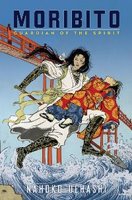
One of the first things I had to learn about writing for children back when I was getting started was that kids' books were about kids. They got the best lines. The action needed to be around them. In a good kids' book, the kids saved themselves, adults didn't save them.
Moribito: Guardian of the Spirit by Nahoko Yehashi, winner of the Mildred L. Batchelder Award, breaks that rule in spades.
Take a look at that beautiful cover. The stunning spear-wielding warrior is a thirty-year-old woman described on page one as having a face "tanned and beginning to show fine wrinkles." The cover illustrates the opening scene in which Balsa, a martial artist for hire, saves an eleven-year-old prince. Note that we don't even see his face. The balance of power between characters is made clear before the book is even opened.
The story opens with Balsa. It closes with Balsa. She is the character who changes as a result of the events in the story. An argument can be made that nothing changes for the prince, who functions as a sort of vessel for a spirit egg that has been placed inside him without his knowledge.
Moribito: Guardian of the Spirit is told in the third person with point-of-view shifts among characters by chapter. These shifts occur among adult characters until half way through the book when a chapter from the child's point of view appears. Later in the book, point-of-view shifts appear within chapters, including shifts to the young prince. I don't believe he gets another chapter to himself, though. That's probably just as well because he's nowhere near as interesting as all the grown-ups around him.
One strange YA book? Yes, indeed. Until you realize that the Mildred L. Batchelder Award is given "for the most outstanding children’s book originally published in a language other than English in a country other than the United States, and subsequently translated into English for publication in the United States." (Got that?) Moribito: Guardian of the Spirit is a Japanese book translated by Cathy Hirano. It's the first in a series that's supposed to have sold 1.5 million copies in Japan and has appeared there in both anime and manga.
I know that one title does not make a statistically significant number, but after reading Moribito I'm wondering if kids in other cultures do read about adults, whereas here, not so much.
Cartoon Network's Adult Swim aired the anime version of Moribito: Guardian of the Spirit last year. That ended in January, though.
Scholastic will be publishing Moribito: Guardian of the Darkness this summer.
Training Report: Between yesterday and today I did four 365 Story Project segments. That would sound a whole lot better if I hadn't missed three, maybe four days for the holiday weekend. Plus, I've decided to replace a couple of yoga segments I did a while back with an ice skating segment I did today and another I plan to do tomorrow. So I'm thinking I'm just getting further and further into the hole. I also spent some time today trying to sign up for AmazonConnect, which is supposed to allow authors to do some kind of promotion on the pages advertising their books. However, when I tried to do something called "verifying," I got a message saying there was some kind of problem, hope you don't mind too much. Yes, this is minor Amazon news compared to what was happening there this weekend.
2 comments:
I read a lot of Japanese YA. I would say that the majority is about teenagers, but the disparity isn't quite as intense as it is in the US. You'll see examples, especially in contemporary or near-future settings, where the main characters are adults -- usually youngish adults, in their twenties -- occupying roles that teenagers might not be able to occupy: soldiers, police officers, detectives, professional musicians or actors or fashion designers. But I do think that Moribito is an outlier in that respect.
Okay. That makes Moribito even more interesting.
As luck would have it, I've been listening to Outliers.
Post a Comment